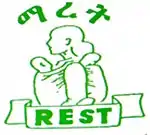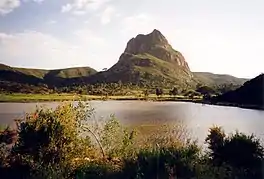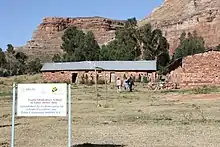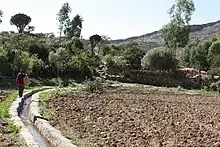 | |
| Founded | 1 January 1978 |
|---|---|
| Founded at | Tigray |
| Type | NGO |
| Focus | Poverty eradication disaster relief advocacy |
| Headquarters | Mekelle, Tigray |
Area served | Tigray Region |
Executive Director | Teklewoini Assefa[1] |
Employees | 1010 (in 2012) |
| Managing director (2021): Heshe Lemma | |

The Relief Society of Tigray (abbreviated REST; Tigrinya: ማሕበራዊ ረዲኤት ትግራይ or ማረት, Maret) is an NGO based in Tigray, northern Ethiopia.[2] REST was founded in 1978 as an organisation providing relief efforts to civilians.[3] As of 2008, Teklewoini Assefa served as Executive Director of REST.[3] REST emerged as the humanitarian wing of the Tigray People's Liberation Front (TPLF) and has remained closely linked to TPLF.[4][5] REST was active throughout the armed conflict of the 1980s, including during the devastating 1984–1985 famine.[3] Since the 1990s it is the major NGO operating in Tigray.
Emergence and civil war of the 1980s
Prior to the TPLF and Ethiopian People's Revolutionary Democratic Front (EPRDF) overthrowing the Derg government in 1991, REST worked in the areas under the control of the TPLF, operating over 60 schools and 53 clinics. The organization had a literacy programme, which claimed to have educated 405,834 persons in the period of 1981 to 1983. REST also sought to provide clean drinking water in these areas.[6] Through TPLF resources from the Tigrayan diaspora in North America and Europe and different NGOs were channeled to Tigray.[7] In 1981 the Emergency Relief Desk was set up in Khartoum, as a consortium of Scandinavian ecumenical NGOs cooperating with REST and the Eritrean Relief Association (the humanitarian wing of the EPLF). The ERD provided food supplies to the Sudanese border, where it was picked up by REST and ERA to be distributed in Tigray and Eritrea.[8] In contrast Western governments avoided direct links with REST, continuing to channel aid efforts through the official mechanisms in cooperation with the Addis Ababa government.[7][8]
Famine
REST played a crucial role to undercut the Addis Ababa government's attempts to use famine as a means to obtain control over Tigray.[7] However, at the onset of the 1984–1985 famine REST suffered from logistical constraints. The organization had only 35 trucks, out of which many were in bad shape. Unable to cope with the humanitarian disaster, REST and TPLF decided to encourage Tigrayans to seek food at distribution centres operated by the Addis Ababa government.[9] The policy of encouraging movements to government feeding centres was reversed, as abuses were committed in those places. Now, people were asked to migrate towards western Tigray and onwards to Sudan.[10] Along the road REST organized distribution points for food, water and some degree of shelter.[10] The organization also provided rudimentary medical services were available.[10] Often REST would lead entire village groups into Sudan, were refugee camps were set up by the organization.[11]
Through its work during the famine, REST gained recognition amongst international NGOs. It also managed to change the attitude of the Sudanese government towards the resistance movements in Ethiopia (allowing the TPLF to operate, whilst ending support to the Ethiopian Democratic Union).[12]
Locusts
In the summer of 1987 Tigray was hit by a locust invasion, threatening crops. The organization lobbied, through its office in Khartoum, that the ICRC would send two helicopters to spray against locusts (an operation that eventually got the necessary go-ahead permission from the government in Addis Ababa). The locust problem again returned in 1988. REST also organized, along with TPLF, a volunteer force that would spray crops on the ground. A slogan was launched, "Fight the locusts with chemicals and the Derg with guns".[13]
Post 1991

After the end of the war and the fall of the Derg, REST worked with refugee repatriations. The organization signed treaties with the Transitional Government of Ethiopia and UNHCR for these activities.[14] REST provided humanitarian assistance for Tigrayan population during the 1998–2000 Ethiopian-Eritrean war.[4]
A 1996 document, circulated amongst diplomatic circles in Addis Ababa, alleged that REST (along with other organizations) channeled funds to the governing Ethiopian People's Revolutionary Democratic Front.[15]
In recent years, foreign government funding to REST has increased.[4] As of 2008, the Norwegian Development Fund was the largest donor to REST.[3] REST held its sixth General Assembly in 2008.[3]


Activities in the decades of peace (1990–2020)

Guiding objectives
In 2012, REST had the following guiding objectives for its activities in the Tigray Region:
* to reduce current high levels of chronic household food insecurity
- to empower communities and most poor and vulnerable individuals
- to promote equity in development
- to promote the sustainable usage of renewable and non-renewable natural resources
— REST, 2012 Annual Report, [1]
Potable water
In numerous villages of Tigray, REST has established hand pumps, to provide the community with clean water. Each pump serves a few hundred people, and is managed by the community, who will appoint a guard, and a "water committee" that collects user fees and verifies cleanness.[16] As a consequence, communities become more resilient to shocks and social interaction improves.[17] The plight of women and girls, who traditionally care for water provisioning, is reduced. They spent less time, because less walking to distant springs, so that it is easier to attend school or do productive work.[18] Just in 2012, REST has constructed 876 new hand dug wells, and provided clean water to 298,557 people in Tigray.[1]

Besides its involvement with the SAERT dam building programme, REST has also built several reservoirs such as
Natural resources management
REST has continued and strongly enhanced the management of natural resources that was started in the civil war period of the 1980s. This includes the establishment of community managed exclosures, construction of soil and water conservation infrastructure, reclamation of gullies, all encompassed in global catchment management initiatives. As a consequence the baseflow in rivers improves, and the water can be used to establish irrigation schemes[19]
- Exclosures established by REST have been demonstrate to enhance vegetation growth, rehabilitate the environment, control erosion and enhance infiltration.[20][21]

- Gully reclamation allows turning otherwise dry scars into "linear oases" with good vegetation and sometimes fruit trees. Runoff is slowed down also and no more erosion occurs.[22]
- Terracing of agricultural land through stone bunds leads to more level land, with less erosion and better crop growth.[23][24]

- Terracing of steep hillsides leads to ponding water and enhances infiltration, that will partly benefit vegetation regrowth and also raise the water table.[25]
It has been demonstrated also that such land terraced by REST was able to absorb runoff coming in from upslope.[26] In total, by 2012, REST had created 1733 km2 of exclosures.[1]
Smallholder livelihoods
All the abovementioned initiatives contribute to the livelihoods of smallholder farmers. In addition, REST supports the creation of marketing groups of agricultural produce such as honey or milk.[27] For instance, in 2012, newly created cooperatives benefited to 23,429 farmers.[1]
Empowerment
Through its activities and by targeted capacity building, REST contributes to empowering women, farmers, and overall the rural households.[28][1]

Health and education

REST promotes community health by organising health training and nutrition promotion services. In 2012 this benefited to 17,380 child and adult students.[1]
Social protection

REST is strongly involved in the Productive Safety Net Programme, the major social protection programme in Africa. The poorest people get food aid, through their participation in rehabilitation and other community work.[29] Though the PSNP has sometimes been criticised for politicisation and unfair selection of beneficiaries,[30] overall it has been demonstrated that aid provided through PSNP was reaching the poorest of the poor.[31] In 2012, REST reached over 860,000 people in need through the Productive Safety Net Programme.[1]

During the Tigray war: from development work to humanitarian aid

During the Tigray War, one of the big problems to distribute aid was the absence of structures to reach out the needy. Before the war the Relief Society of Tigray (REST) was the main organised institution for this, but REST was having a lot of problems during the occupation by ENDF, EDF and fanno militias. REST's board members were replaced, with Amhara people dominating the board; REST's 33 warehouses in various woredas (with capacities of 700 – 1000 tons) have been destroyed; 11 offices have been looted; 70 trucks and vehicles have been looted; and other Tigray-based NGOs have been forced to defame REST. Despite all this USAID and CRF delivered aid through REST, aiming at reaching 1.3 million people.[32]
During the conflict, the different humanitarian organizations (i.e. WFP, REST, WV, CARE, FH) have actively engaged in food distributions in different parts of the region. For instance, the Relief Society of Tigray reached more than 1 million people with food aid (in cooperation with USAID) per month in the first half of 2021.[33][34]
In total, 2.2 million people were reached with food aid, distributed by REST (38%), WFP (37%), World Vision (WV; 12%), Food for the Hungry (FV; 8%) and CARE (5%).[32]
See also
References
- 1 2 3 4 5 6 7 8 "Relief Society of Tigray 2012 Annual Report" (PDF). 2012. Retrieved 29 July 2021.
- ↑ Laura Hammond (2004), This Place Will Become Home: Refugee Repatriation to Ethiopia, Cornell University Press, p. 36, ISBN 0-8014-8939-3
- 1 2 3 4 5 Royal Norwegian Embassy in Addis Ababa. Relief Society of Tigray celebrates 30th Anniversary
- 1 2 3 Shinn, David H., and Thomas P. Ofcansky. Historical Dictionary of Ethiopia. Lanham, MD: Scarecrow Press, 2004. pp. 343–344
- ↑ Coote, Mike. Does Our Money Really Help?: Life in Ethiopia. Bloomington, Ind: AuthorHouse, 2007. p. 25
- ↑ Inquai, Solomon. Tigrai: The Agony and the Ecstasy. [Ethiopia?]: Printed by Berhanena Selam Printing Enterprises, 2007. pp. 76, 83
- 1 2 3 Koonings, Kees. Political Armies: The Military and Nation Building in the Age of Democracy. New York: Zed Books, 2002. pp. 251–252
- 1 2 Duffield, Mark. Development, Security and Unending War: Governing the World of Peoples. Cambridge [u.a.]: Polity Press, 2008. p. 73
- ↑ Inquai, Solomon. Tigrai: The Agony and the Ecstasy. [Ethiopia?]: Printed by Berhanena Selam Printing Enterprises, 2007. pp. 143–144
- 1 2 3 Inquai, Solomon. Tigrai: The Agony and the Ecstasy. [Ethiopia?]: Printed by Berhanena Selam Printing Enterprises, 2007. pp. 64, 146–147
- ↑ Ashmore, Joseph, Jon Fowler, and James Kennedy. Shelter Projects, 2008. Nairobi, Kenya: UN HABITAT, 2008. p. 106
- ↑ Young, John. Peasant Revolution in Ethiopia: The Tigray People's Liberation Front, 1975–1991. Cambridge, U.K.: Cambridge University Press, 2006. p. 134
- ↑ Inquai, Solomon. Tigrai: The Agony and the Ecstasy. [Ethiopia?]: Printed by Berhanena Selam Printing Enterprises, 2007. pp. 127–129
- ↑ Hammond, Laura. This Place Will Become Home: Refugee Repatriation to Ethiopia. Ithaca: Cornell University Press, 2004. p. 191
- ↑ Merera Gudina. Ethiopia: From Autocracy to Revolutionary Democracy, 1960s–2011. Addis Ababa: [s.n.], 2011. pp. 113, 142
- ↑ Charity:water Gerebgereb (May Tekoso)
- ↑ Norad End Review of Sustainable Agricultural Program in Tigray National Regional State Implemented by DF in Partnership with the Relief Society of Tigray (REST) and Women's Association of Tigray (WAT).
- ↑ Ayenew Admasu, Meresa Kiros, Abdulkadir Memhur, 2011: Baseline survey report of tigray region on WASH.
- ↑ USAID, TOPS, FSNetwork, 2017: REST’s 3-R Approach to Natural Resource Management
- ↑ Aerts, R., E. November, M. Behailu, J. Deckers, M. Hermy, and B. Muys. 2002. Forest rehabilitation: one approach to water conservation in Central Tigray. Ethiopian Journal of Water Science and Technology 6: 34–37.
- ↑ Wolde Mekuria and colleagues, 2009: Effectiveness of exclosures to control soil erosion and local community perception on soil erosion in Tigray, Ethiopia. African Journal of Agricultural Research Vol. 4 (4), pp. 365–377.
- ↑ Gebrehiwet Gebru, 2017: The Relief Society of Tigray (REST) environmental rehabilitation and agricultural development
- ↑ Jan Nyssen and colleagues, 2007: [https://biblio.ugent.be/publication/378900/file/738003.pdf Interdisciplinary on-site evaluation of stone bunds to control soil erosion on cropland in Northern Ethiopia
- ↑ Soil conservation in Tigray, Ethiopia
- ↑ Ben Parker, 2003 Ethiopia: Breaking New Ground, p 33
- ↑ Etefa Guyassa Dinssa, Amaury Frankl, Amanuel Zenebe, Miro Jacob, Motuma Tolera, Abebe Damtew, K Descheemaeker, Jean Poesen and Jan Nyssen, 2017. From runoff contributor to runoff absorber: spate irrigation on exclosures in Tigray, northern Ethiopia
- ↑ REST annual report 2007
- ↑ CARE: Feed the Future Ethiopia – Livelihoods for Resilience Activity
- ↑ An overview of REST’s implementation of the Productive Safety Net Programme
- ↑ Kaatje Segers, Joost Dessein, Jan Nyssen, Mitiku Haile and Jozef Deckers, 2008. Developers and farmers intertwining interventions: the case of rainwater harvesting and food-for-work in Degua Temben, Tigray, Ethiopia. INTERNATIONAL JOURNAL OF AGRICULTURAL SUSTAINABILITY, 6(3), 173–182.
- ↑ Azadi, Hossein, Fien De Rudder, Koen Vlassenroot, Fredu Nega, and Jan Nyssen. 2017. Targeting International Food Aid Programmes : the Case of Productive Safety Net Programme in Tigray, Ethiopia. Sustainability 9 (10).
- 1 2 Annys, S., Vanden Bempt, T., Negash, E., De Sloover, L., Nyssen, J., 2021. Tigray: Atlas of the humanitarian situation
- ↑ CARE, 19 April 2021. Worries rise for Tigray residents’ longer-term safety.
- ↑ WFP, 1 June 2021. WFP reaches over 1 million people with emergency food assistance in Tigray.